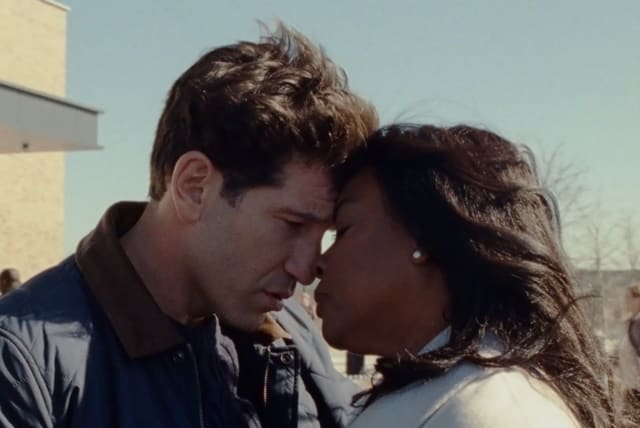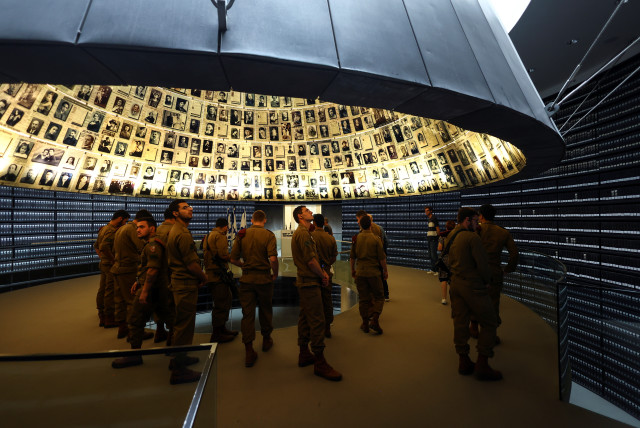‘Origin’ story: How Ava DuVernay’s new movie connects the Holocaust, slavery and caste

The film opens with the 2012 murder of Black teenager Trayvon Martin in Florida, later recreating Nazi-era Germany, the Jim Crow South and other moments it connects through the idea of caste.
(JTA) — Early in the new drama “Origin,” the Pulitzer Prize-winning Black author Isabel Wilkerson (played by Aunjanue Ellis-Taylor) calls her cousin from Berlin to share that, as part of her research into American racism, she intends to learn more about the Nazis’ treatment of Jews.
Her cousin is unimpressed.
“Leave Jewish folks alone,” Marion (Niecy Nash) advises Isabel. “They don’t need you. Write about us.”
But this movie’s version of Wilkerson can’t abide by that. In her mind, the fates of Jews and Black people are connected by the hidden system of “caste”: arbitrary societal hierarchies that encourage cruelty and subjugation. This is the thesis undergirding “Caste: The Origins of Our Discontents,” the 2020 bestseller by the real-life Wilkerson, which deems Nazism and American racism — alongside India’s own rigid caste system — as the caste systems that have “stood out” the most “throughout human history.”
And “Origin,” the new film by Ava DuVernay now in theaters and based in part on this book, is devoted to making those connections plain.
Here’s a Jewish guide to what “Origin” has to say about the Nazis and their connection to Wilkerson’s broader thesis.
What is ‘Origin’ about?
Written and directed by DuVernay (“Selma,” “When They See Us”), “Origin” is a dramatization of the writing of Wilkerson’s “Caste” that uses historical recreations and the author’s own family story to capture the book’s cerebral tone.
The film opens with the 2012 murder of Black teenager Trayvon Martin in Florida, later recreating Nazi-era Germany, the Jim Crow South and other moments it connects through the idea of caste.
Well-regarded 20th-century Jewish texts make up some of the onscreen Wilkerson’s research process, including a quote by Holocaust survivor Primo Levi and glimpses of the 1956 anthropological book “Israel Between East And West,” by Raphael Patai. Palestinians are also name-dropped at one point, with a scholar from the Dalit caste — the “untouchable” lowest tier of India’s caste system — telling Wilkerson he feels a kinship with them as well as Black people.
The book “Caste” itself has sometimes been attacked in recent years as an example of “critical race theory,” an academic analysis of racist structures that conservatives say amounts to indoctrination and have sought to ban from classrooms. Wilkerson’s book is one of about a dozen at the center of an ongoing lawsuit involving a Texas public library that had tried to remove a selection of titles against the wishes of some residents; another is the picture book “In The Night Kitchen,” by the Jewish author Maurice Sendak.
“Caste” is also being targeted by a Texas Republican state representative as one of 850 books that he says “might make students feel discomfort, guilt, anguish, or any other form of psychological distress because of their race or sex.”
Jim Crow and the Nuremberg Laws
One Nazi-era event dramatized in “Origin” is the 1935 drafting of the Nuremberg Laws, the race-purity strictures that declared Jews to be racially inferior and outlawed relations between them and Germans.
The film emphasizes the fact that the real-life Nazi officials who came up with the laws drew heavy inspiration from the Jim Crow South’s segregation laws, which made it a crime for Black and white people in the South to enter relationships, attend the same schools or share the same public spaces.
Wilkerson’s book notes that the Nazis could not understand why the Americans hadn’t included Jews in their race laws “when it was so obvious to the Nazis that Jews were a separate ‘race’ and when America had already shown some aversion by imposing quotas on Jewish immigration.” The film’s version of Wilkerson tells a relative at one point, “The Jews and the Nazis were the same color,” emphasizing that caste isn’t necessarily about skin color.
‘The man in the crowd’
Another Nazi-era event DuVernay dramatizes is a famous photograph of German shipyard workers in 1936 delivering the “Heil Hitler” salute. One man in the photo is standing with his arms folded, apparently refusing to pledge his loyalty.
It’s an image that has gone viral in recent years and that Wilkerson included as an opening anecdote in “Caste” to illustrate the power of being a lone voice against injustice. In the years since the photograph was taken, the man has been identified by a living relative as August Landmesser, a one-time Nazi Party member who had fallen in love with a Jewish woman the year before the photo was taken.
“Origin” imagines the courtship between Landmesser and his Jewish lover, Irma Eckler, as playing out in secret, via clandestine meetings in jazz clubs, defying the Nazis’ caste structures. Eventually, the couple have children and try to flee across the border but are arrested for violating the Nuremberg Laws, which forbade “pureblooded” Germans like Landmesser from romancing Jews.
In real life, according to a family history authored by one of the couple’s daughters, Landmesser was sent to prison and then drafted to fight for the Nazis in 1944, declared missing in action and believed dead before the war ended. Eckler was sent to a concentration camp and sent her last recorded letter in 1942.
Nazi book bans and Remarque
Perhaps inspired by recent book-banning efforts in the United States, DuVernay’s film also heavily emphasizes the Nazis’ own book-burning practices. A segment showing Wilkerson’s research visit to Berlin lingers on the city’s book burning memorial, “The Empty Library,” an underground illuminated sculpture of empty white shelves. Designed by the acclaimed Israeli artist Micha Ullman, the sculpture’s image in the film is given more screen time than even the city’s more famous Memorial to the Murdered Jews of Europe, and is accompanied by flashbacks of a public Nazi book burning taking place.
One book in particular is frequently name-dropped in the film as a target of the Nazis, although its Jewish history is considerably more complicated: the World War I novel “All Quiet On The Western Front.” The book’s German author, Erich Maria Remarque, was frequently accused by the Nazis of being Jewish, though he wasn’t; his antiwar novel, which is heavily critical of Germany’s military failures, was seen by the Nazis as demoralizing, as was its initial 1930 film adaptation, directed by a Jew. The book was recently remade into a Netflix movie that was heavily decorated with Oscar nominations.
Subjugation vs. extermination
Also during Wilkerson’s Berlin visit in the film, she gets into an argument with a German academic over the efficacy of linking slavery to the Holocaust.
While slavery persisted for several generations and involved unspeakable suffering, the companion states, the fundamental aims were different: slavery was an arm of capitalism designed to exploit humans for profit, while the Holocaust was a project to exterminate all Jews from the earth.
It’s an argument that has often proved heated in the US in recent years, as some Jews have fought against race-based history concepts that they claim prioritize Black suffering over their own. A Jewish leader in the right-wing parent activist group Moms For Liberty told JTA last year that she was inspired to campaign against public education after her daughter faced a quiz question in school whose “correct” answer was that slavery was worse than the Holocaust, which she said she considered “a Holocaust-minimizing question.”
Undeterred, the film’s Wilkerson continues to insist on the resemblance between the two on the basis of caste: that both institutions served to designate a lower class of people who could be mistreated by an upper caste as “an undifferentiated mass of nameless, faceless scapegoats.”
A late-in-the-film montage makes this point explicit, as it cuts between scenes of Jewish women and children being abused at a concentration camp; Black women being abused onboard a slave ship, and the murder of Trayvon Martin.
Jerusalem Post Store
`; document.getElementById("linkPremium").innerHTML = cont; var divWithLink = document.getElementById("premium-link"); if (divWithLink !== null && divWithLink !== 'undefined') { divWithLink.style.border = "solid 1px #cb0f3e"; divWithLink.style.textAlign = "center"; divWithLink.style.marginBottom = "15px"; divWithLink.style.marginTop = "15px"; divWithLink.style.width = "100%"; divWithLink.style.backgroundColor = "#122952"; divWithLink.style.color = "#ffffff"; divWithLink.style.lineHeight = "1.5"; } } (function (v, i) { });

